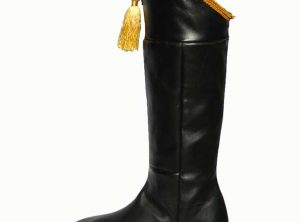
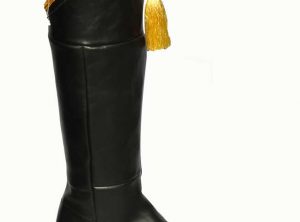
Hessian boot re-production
Fugawee’s Hessian boot is another well made long lasting leather boot, Steel shank construction. Stacked leather heel, fully lined. The boots do not come with a tassel, These have a narrow shaft so those with large calves they might not work for you.
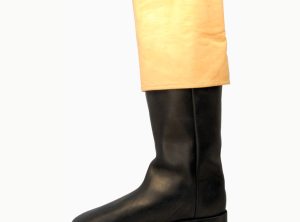
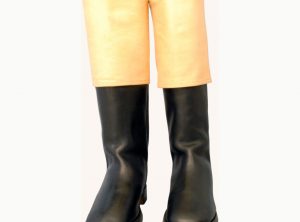
Revere Boot, turn down cuff
The Revere boot is built upon a squarish antique last. It has a rounded shank that fits a stirrup well. The shank is held in place by pegs but the rest of the sole is lock-stitched. The Revere boot has a steam-molded front piece and a full calfskin lining. The exterior is polished black calfskin.
The boot is almost a straight last but indeed it is a left/right. This will make it more comfortable for walking. Please mark somewhere inside which is for the right foot. My husband had not done this and about mid-day he wondered why his feet didn’t feel right. Sure enough, he had put them on the wrong way. After that all was good. So we suggest that you mark the inside for each foot.
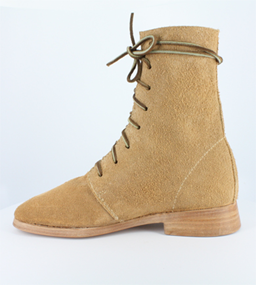
Liquidation sale, No returns. Colonial Natural Half Boots, Trekker series left/right rough-out
The Natural Half Boot, NHB, is a left/right boot. 4 ” above the ankle, with 7 lace holes, it is an all leather, natural color, rough-out leather half boot. Widths a D and EE, sizes full and half 7 to 15. Good for Colonial and later times.
CLOSE OUT – ALL SALES FINAL
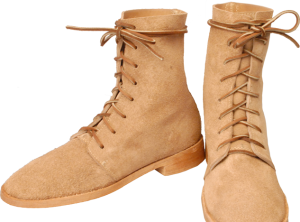
Liquidation sale, No returns. Hi-Low Trekkers, straight last, natural rough-out leather
Hi-Lows are the straight last in the Trekker series. All leather natural rough-out, lace up half boot. sizes 6 to 15
CLOSE OUT – ALL SALES FINAL
If you look at the American Rifleman article on muskets of the Revolution, you will see that Troiani portrays General Warren standing atop the parapet with sword in hand as he waits to see “the whites of their eyes.” He is wearing black Hi-Lows / Black Half Boots.
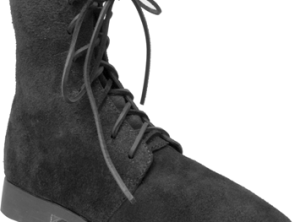
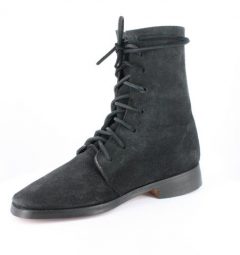
Liquidation sale, No returns. Colonial Black Half Boot, Trekker series Left/right
Four inches above the ankle, lace-up black all leather half boot. Good in F&I era to Mexican War 1812.
Full and half sizes 7D to 15EE, price $176.49
CLOSE OUT – ALL SALES FINAL
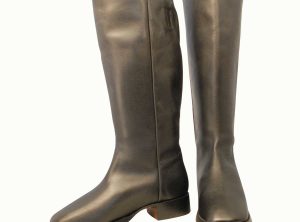
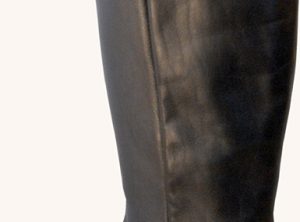
Historic Stovepipe Boot, black smooth side out
The Stovepipe is close to all around or common boot. It comes high on the leg, almost to the knee. The leg is wider so the trousers can be tucked in them. It is a two piece pattern with 1 1/4″ stacked heel. It has inside pull tabs to make it easier to pull on.
Fugawee has received several inquiries about the authenticity of the Hi-Low also called Startup, upstart, buskin or half-boot. They are all names for the same footwear, a boot not too different from the modern-day work boot. I’m going to poke around and much of what I write will seem to be disjointed……but then all of historical research consists of putting together the bits and pieces left behind. June Swann is considered by most people to be the ultimate authority of historical footwear. She has a long and honorable career as author and museum curator.
June Swann says, in “Shoes” (ISBN 0 7134 0942 8) P.28:
“There were also half boots from the 1750s, cut a little higher than modern ankle boots, which descend from them and worn for shooting and by the military. St James Chronicle, 1763, comments on ‘tradesmen who ape their betters….breeches almost met by a pair of shoes that reached about three and a quarter inches above the ankles.’ They were typical wear for both sides during the American War of Independence (see Peale’s portrait of Captain John Harleston of Chicago.”
I have tried to track down the Harleston portrait without luck.
Three and a quarter inches above the ankle makes an eight-inch boot. Remember that the St. James Chronicle was a snob’s gazette and was ridiculing the ‘tradesmen who ape their betters.’ Was this the foundation for the term ‘upstart’?
A little before this, in 1745 an English painting shows a sportsman using such shoes for hunting on foot. The term used by the English was ‘buskin’, called after the classical Greek-Roman footwear which was a high, laced sandal.
Similar high laced shoes appear as far back as the middle ages, about the time that people got tired of wearing wooden shoes full of manure. The hi-lows were made with tongues and without tongues. The pair pictured in the Collector’s Encyclopaedia of the American Revolution does not have tongues. It is called an ‘overshoe’ and is said to have belonged to Thomas Jefferson.
In the Colonies, the hi-low was a farm boot meant for the barnyard and pig-stye in a day when there were no rubber boots. Do you wonder that surviving specimens are hard to find?
It is just such a farmer’s boot that Don Troiani shows on his Lexington Minute Man.
Someone asked Nancy, ”Where did Troiani get his authentication?”
If there is one man I would never question on such matters, it is Don Troiani.
Then there is Al Saguto, long time resident cordwainer at Historical Williamsburg: He says,
One detail from the surviving 18th c. boots: where the original lacing survives, it’s always “spiral” laced, that is the length of thong is knotted at one end
[the bottom], and it spirals round and round up the front opening, then is half-hitch looped, and the other end tucked inside the boot……. DA SagutoAl made the first pair of reproduction hi-lows for a customer several years ago and deserves credit for bringing back a safe and comfortable shoe for Colonial re-enactors. He does only bespoke work and has a waiting line but it is worth it.

